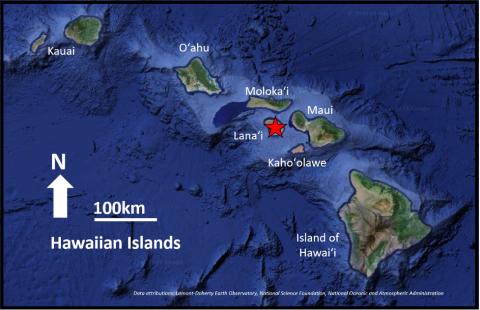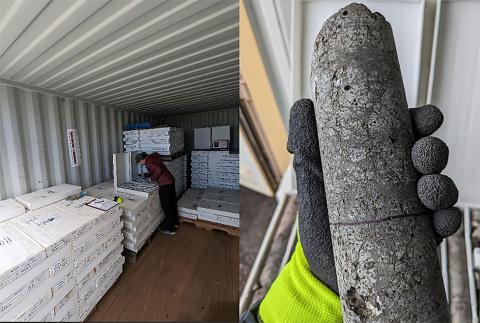Researchers: Serena Formenti, with Dr. Lauren Harrison, Dr. Dominique Weis
What question or problem are your trying to address?
The Hawaiian Islands are composed of a series of volcanoes, which erupt lavas sourced from very deep (~2900 km) within Earth’s middle layer, the mantle. The volcanoes are formed from a mantle plume, which acts as a thermal-chemical conveyer belt to the surface of the Earth. Research has shown that the mantle is extremely heterogeneous, meaning that the sources of these lavas are different (French and Romanowicz 2015). By studying Hawaiian volcanoes that erupt these deeply sourced lavas, we can study the deep Earth, which is otherwise inaccessible.
Lanaʻi is a unique volcano that erupts some of the most geochemically enriched lavas in Hawaiʻi (West et al. 1992). There are only two other volcanoes (Kahoʻolawe and Koʻolau) out of the 15 main volcanoes that make up the Hawaiian Islands that erupt these types of lavas (Fig. 1). The chemical compositions of Lanaʻi’s lavas have anomalously high concentrations of trace elements, in addition to isotope signatures that differ from the main Hawaiian volcanoes. This indicates 1) a different lava source, from deep within the Earth or 2) different melting and eruption regimes, or, most likely, a combination thereof. Using samples from a vertical rock core (Fig. 2) of the Lanaʻi volcano, my research investigates the following questions:
- What is the geochemical composition of Lanaʻi?
- What information do sequential lava flows of the most enriched geochemical signatures, recorded in a drill core, reveal about the structure of the Hawaiian Mantle Plume?

Why is this research important?
The unique enriched lavas that make up Lanaʻi are indicative of a chemical extreme of the Hawaiian deep mantle source. Because we cannot physically access Earth’s mantle, we can only rely on erupting lavas and geophysical surveys to hypothesize what this area looks like and what it is made of. Lanaʻi not only provides a window deep into the Earth, but it provides evidence and chemical compositions of a unique mantle heterogeneity.
How will you accomplish your research?
In January, 2024, Dr. Lauren Harrison from Colorado State University and I travelled to Hawaiʻi and collected 75 samples of sequential lava flows from a rock core of Lanaʻi (Fig. 2). Here at UBC, I am undertaking a thorough characterization of these samples to determine their source composition.
This includes:
- Inspection of rock sample thin sections under a microscope to determine their mineral compositions
- Major elements (e.g., silicon, magnesium and calcium)
- Trace elements (e.g., small concentrations of metals)
- Radiogenic isotope ratios (e.g., lead, strontium, neodymium and hafnium)
The unique geochemical compositions of the rocks speak to their geologic history and mantle source.

What do you hope to find or what are your main findings?
In Hawaiʻi, there exists two unique types of lavas, characterized by their chemical compositions (Abouchami et al. 2005). These lava compositions are known as Loa and Kea, named after the largest volcanoes made of each composition (Mauna Loa and Mauna Kea). Lanaʻi, as well as Kahoʻolawe and Koʻolau volcanoes, show a third lava type named Enriched Loa, which resembles the most chemical extreme of Loa-type lavas.
From this project, I hope to provide a detailed geochemical record of the Enriched Loa component, and to determine the source of the enriched signatures, whether it be from the deep mantle or from melting regimes, or a combination thereof.
References
Abouchami, W., Hofmann, A.W., Galer, S.J.G., Frey, F.A., Eisele, J. and Feigenson, M. 2005. Lead Isotopes Reveal Bilateral Asymmetry and Vertical Continuity in the Hawaiian Mantle Plume. Nature, 434 (7035): 851–856.
French, S.W. and Romanowicz, B. 2015. Broad Plumes Rooted at the Base of the Earth’s Mantle beneath Major Hotspots. Nature, 525 (7567): 95–99.
West, H.B., Garcia, M.O., Gerlach, D.C. and Romano, J. 1992. Geochemistry of Tholeiites from Lanai, Hawaii.” Contributions to Mineralogy and Petrology, 112 (4): 520–542.